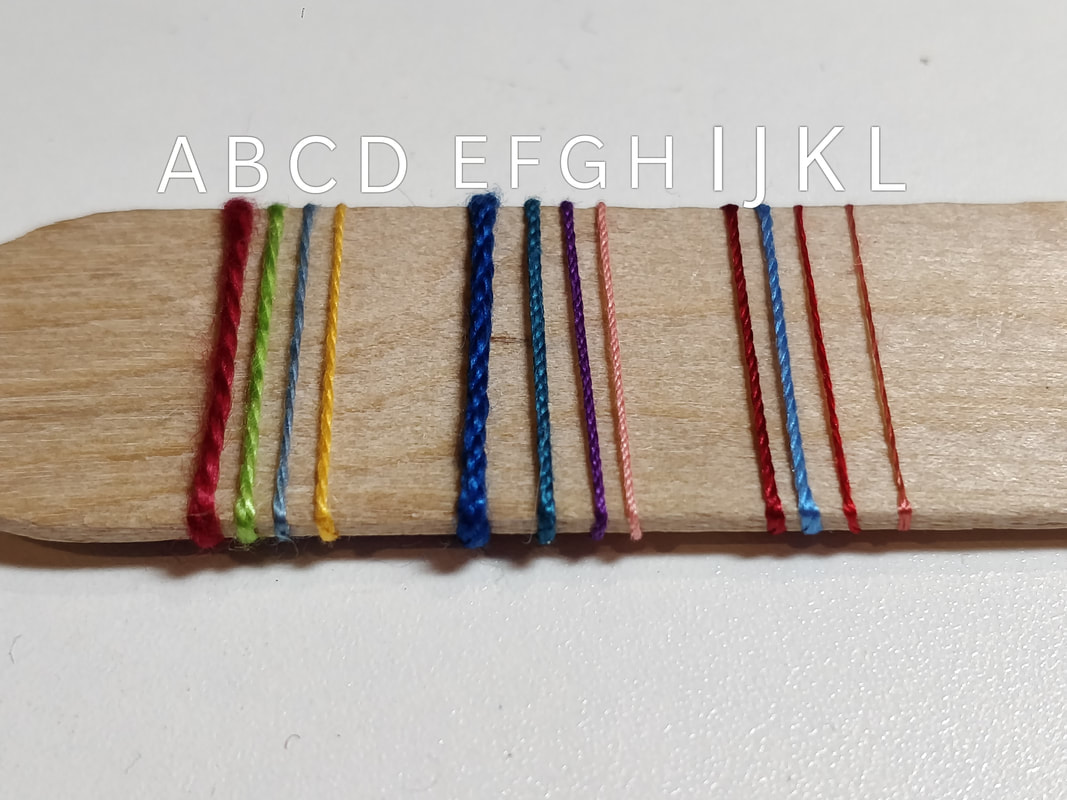Now let's talk materials for the yubinuki of which there is only ONE - THREAD. This is the primary material to make the design. There are several things to consider when selecting the thread for your yubinuki: color, material, and size. I don't think I need to discuss color at this point as that is important for your pattern, which shall be discussed in a later post. But the thread material and size are what be discussed in this post.
First some general information: Material and Size
Thread Material: In Japan, the traditional materials are either cotton or silk which was taken from the remnants of weaving. These are the two fibers still primarily used in modern times. Your skill level, design and personal preference will influence what material that is selected. There are also nice threads in linen, polyester, and blends and are also metal threads which is where a very fine wire is wrapped on a cotton or silk core; with some searching you can find silver, gold, and copper.
Thread Size: Thread size is not actually measured in inches or millimeters; there are 3 major measuring system and each thread manufacturer picks how measure their thread; trust me it is confusing and I learned quite a bit. What is important to know is that the thread size will influence how detailed the design of the pattern can be; the finer the thread the more details the pattern can have. There are 3 ways to measure thread: Weight (meters per 1 gram), Tex/Length (grams per 1000 meters) or Denier ( weight in grams per 9000 meters). Perle cotton is in the weight system and Japanese silk is sometimes given in denier and some I can't figure out at so let not worry about it at this point
Let's now let's look at some actual threads which can be used to make yubinuki. The letters the start of each paragraph refers to the letters in the picture below.
A) Cotton Perle Size 5: A 10 gram ball contains 45 meters.
B) Cotton Perle Size 8: A 10 gram ball contains 80 meters.
C) Cotton Perle Size 12: A 10 gram ball contains 120 meters.
D) Cotton Perle Size 16: On a 10 gram ball which contains 143 meters.
E) Tatting Cotton Weight 10: On a 25 gram spool which contains 112 meters.
F) Tatting Cotton Weight 20: On a 25 grams spool and contains 192 meters.
G) Tatting Cotton Weight 40: On a 25 grams spool contains 274 meters.
H) Sewing Silk Perle: A spool contains about 17.5 yards or 16 meters and is about a cotton perle #12 in size.
I) Silk Perle #16: Labeled as 1000 Denier, which is on a card and contains 20 meters. This is in between a perle size 12 and size 16 and is marked as 0.25 mm in diameter.
J) Silk Perle #9: This is on a card and contains 80 meters. This is finer than a perle size size 16, it could be a perle size 30 but I can't find much information on this size but it is finer than the 1000 denier.
K) Silk Thread: This is on a spool that weighs 23 grams and has 503 meters. There is also a 5 thread assortment, with each bobbin having 40 yards for a total of 200 yards.
It should be mentioned that there are other sized that have not been shown or other threads like cotton or silk floss's as well as various hand/machine sewing threads. Remember as the "size" goes up, the thread diameter gets smaller; if a pattern uses a Perle Size 5 and you want to use Perle Size 8, you will have to take more stitches per division and that may require the overall pattern to be adjusted.
When making your first yubinuki, I suggest starting with a perle of size 5 or size 8 as you will have less stitches and a thicker thread is easier to work with. As experience grows, then move to using size 12 and 16 and eventually you will be using silk "sewing" thread.
I will discuss where to purchase these threads in the next post.


 RSS Feed
RSS Feed
